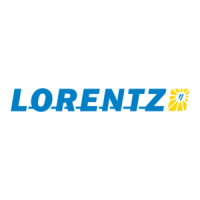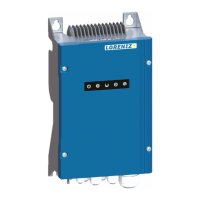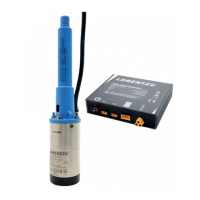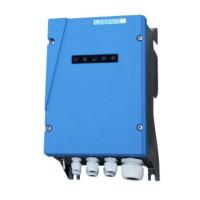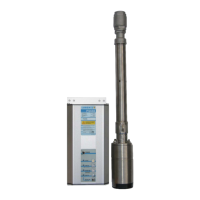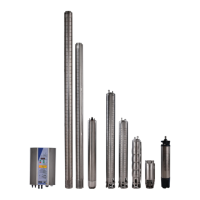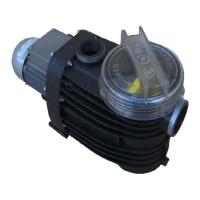Maintenance10
Controller and Pump10.1
Solar Array10.2
Electrical Wiring10.3
Controller and junction box The controller is electronic
with no moving or wearing parts. It requires no mainte-
nance. There are rubber gasket seals at the top and bottom,
and rubber plugs to seal unused conduit holes. Inspect
them to insure that the controller is sealed from moisture,
insects, etc. Check that mounting and conduit hardware
is tight.
Motor The motor is water-lubricated and requires no
maintenance. It is permanently sealed and has no brushes
or other frequently wearing parts.
Pump end The pump mechanism (pump end) is
lubricated only by water and requires no maintenance. It
may wear after some years, especially if there are abrasive
solids in the water. If sand accumulates in the storage tank
or pipes as a result of normal pumping, it is best to take
periodic measurement of the pump’s performance. If the
flow rate is less than normal, see section 9.4. A worn pump
end can be replaced in the field, after the pump is pulled
from the water source.
Power wiring Inspect wires and connections carefully.
Any wires that are hanging loose should be secured to pre-
vent them from swinging in the wind. Exposed wiring must
be sunlight resistant and in good condition. In the case of
a tracking array, look carefully for any wire damage due to
rubbing, bending, or pulling as the tracker swings. If wiring
was not performed to professional standards, improve it to
prevent faults in the future.
Grounding Inspect the grounding system carefully. All
connections must be tight and free of corrosion. Poor
grounding can lead to damage from lightning-induced
surges. See section 5.2
Solar array mounting bolts Bolts tend to loosen as the
array structure flexes in high winds. Check tightness. All
bolts should all have lock washers to keep them tight.
Sun exposure Cut away any vegetation that will grow
enough to block solar illumination. Shading even a small
corner of the solar array may stop the pump, or greatly
reduce its flow.
Solar array cleaning If there is dirt, mineral deposits, bird
droppings or other debris stuck to the solar array surface,
clean it with water, vinegar or glass cleaner.
Solar array tilt Inspect the tilt of the array. The optimum
tilt angle varies with the season. Some people adjust the
tilt twice per year. Other people set it at a single setting as
a permanent compromise. See section 4.5 for details.
Solar Tracker If the system uses a solar tracker, lubricate
the bearings, check mounting bolts and mechanism. Refer
to tracker manufacturer’s instructions.
Standards, Environmental and 11
Temperature Specifications
In all cases, it shall be the responsibility of the customer to
ensure a safe installation in compliance with local, state
and national electrical codes.
PS controllers are built to DIN-VDE regulations and carry
the CE stamp indicating that the European Union electro-
magnetic interference standards (Dt. EMV) have been ful-
filled. Printed circuit boards are conformal-coated against
moisture. The enclosure is thick anodized aluminum,
gasket-sealed and raintight for any outdoor environment
(enclosure class IP55). The controller is suited to tropical
conditions according to IEC 68-2-30. The controller is not
submersible.
Temperature Ranges
Pumps Helical rotor pumps (all without C in the model
number): For pumps in the standard temperature class, the
optimum range of water temperature is 46 °F to 72 °F (8 °C
to 22 °C).
Controller Ambient air temperature –22 °F to 113 °F
(–30 °C to 45 °C). The controller has over-temperature
protection.
Storage Temperature Pump and controller can be
stored (not used) in the range of 0 °F to 120 °F (–20 °C to
50 °C).
